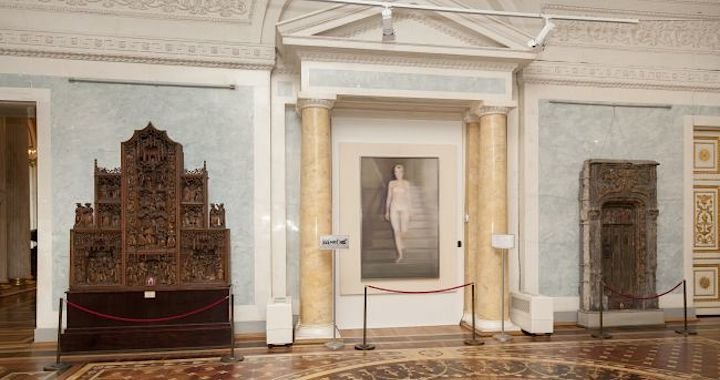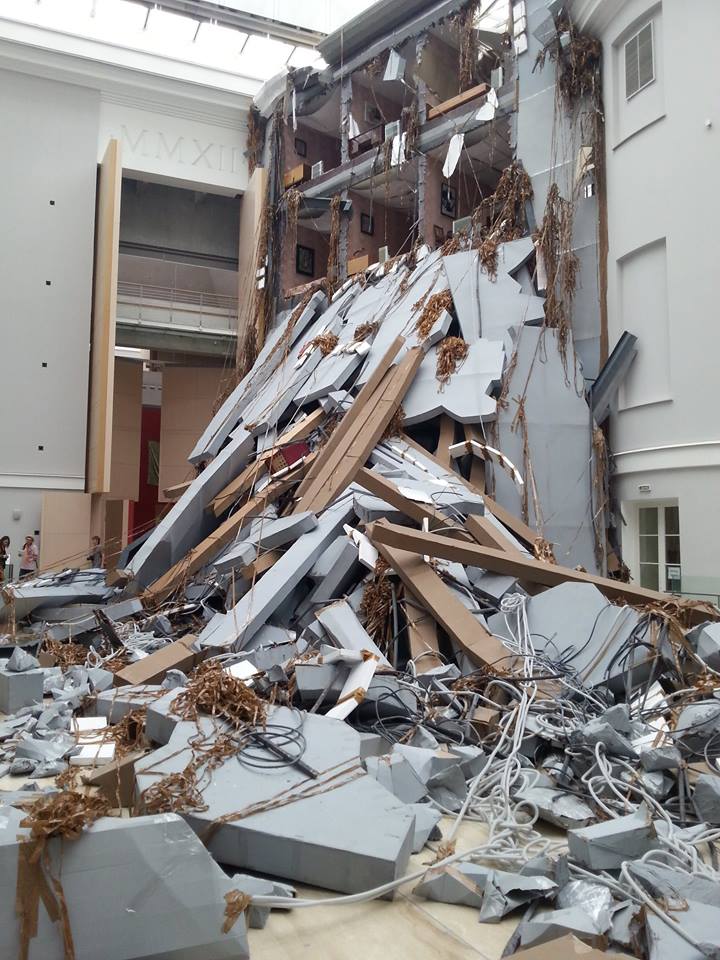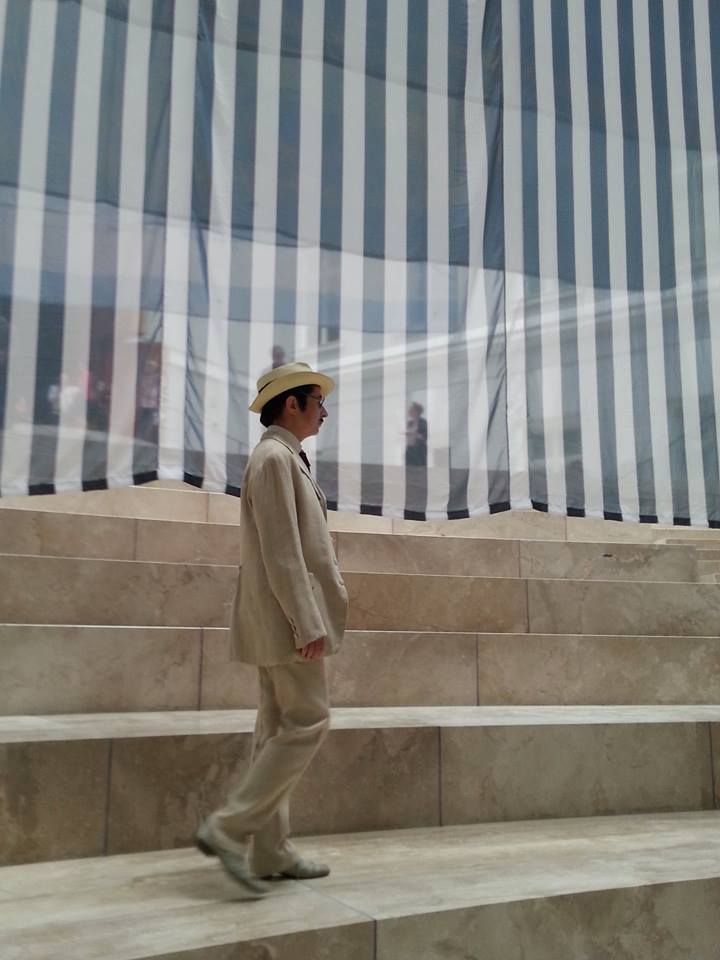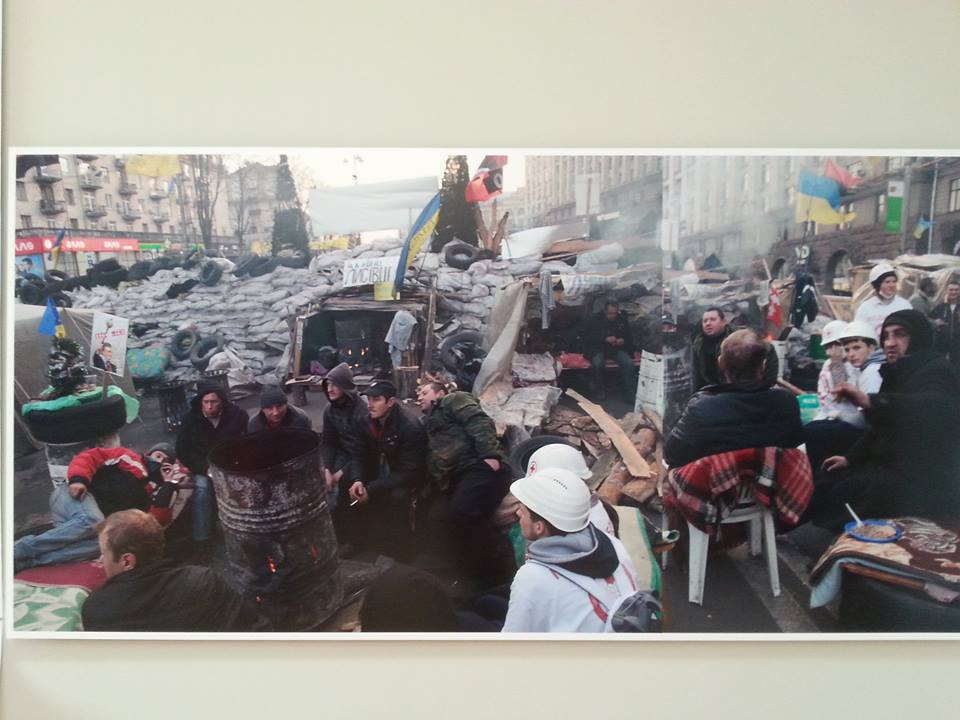
Review: What does Manifesta manifest?
Gleb Yershov
07/07/2014
Manifesta opened, and immediately it became obvious thatloads of contemporary art had come to town. The main programme is housed at the Hermitage, a large part of it – in the General Staff Building but also in the Winter Palace where they are showing modernist masterpieces as well as individual site-specific installations. The city’s social life has perked up. Guests have arrived in huge numbers. Muscowites have temporarily migrated to St Petersburg. The schedule is jam-packed with events, featuring, alongside the main programme, a long if not endless list of exhibitions which belong to the parallel programme and lots of vernissages not included in any official Manifesta listings but nevertheless taking place or scheduled for this three-month marathon of a biennial.
The main project, curated by Kasper König, is vast and comprises both works created specifically for Manifesta and a selection of already existing ones. Among the fifty or so names in the international team of authors, there are some Russian artists: Timur Novikov, Vladislav Mamyshev-Monroe, Pavel Pepperstein, Vadim Fishkin, Elena Kovylina, Alexandra Sukhareva. The first two of them are represented with retrospectives: Novikov’s separate room – ‘chapel’ – is draped in crimson fabric above which his textile pieces are hung (curator Ekaterina Andreyeva); Mamyshev-Monroe’s extensive video programme that includes some early pirate TV footage is shown alongside his collages, scratched photographs and paintings. Novikov’s skyward-bound rockets and planes are followed by Hirschhorn’s ‘Abschlag’, size-wise the grandest among all the installations: horrific ruins of a bombed concrete building of several stories. This impressivemock-up of a structure, apparently intended to remind us of the global tectonic catastrophes of geopolitical scope taking place across the world, also rings a bell on a more local level. It is, after all, a cross-section of a St Petersburg house; its frontage has been knocked down to reveal the interior of actual flats. The artist’s intention was to hang paintings by Pavel Filonov, Olga Rosanova and Kazimir Malevich on the walls as an allusion to the tragic fate of Russian avant-garde; the idea turned out to be hard to pull off in practice.

‘Abschlag’ by Thomas Hirschhorn. Photo by Gleb Yershov
After such an ambitious and pathos-laden statement, a sort of reference to Kiefer’s ruins at Monumenta, you have to enter a burrow: a long and dark passage featuring graffiti and a video starring the Hermitage colony of cats; their on-screen antics are wittily commented on by the Dutch artist Erik van Lieshout. He spent six months in the Hermitage basement trying to understand the life of his new feline friends from the inside and studying the museum insiders’ folklore and tales about the cats. The story of the Hermitage cats sends us back to the beginning of the exhibition, to Juan Muñoz's clever ‘Waiting for Jerry’ installation: a small dark room with a tiny mouse-hole from which bright light is coming, accompanied by the lively soundtrack of the famous cartoon series. Jerry never appears: the artist’s little joke is an ironic reference to video projections where the expectation of an event is sometimes more important than the actual thing.Having emerged from the catacomb ‘intestine’ reminiscent of the Hermitage basement passages, you find yourself in a room featuring a video projection of Elena Kovylina’s ‘Equality’ performance that originally took place a few months ago at the Palace (Dvortsovaya) Square. To theimpassioned music of Beethoven, the camera records the goings-on from the heights of the angel on top of the Alexander Column: a panoramic view of the square; close-ups; long shots. We see a line of people who are standing on high stools of different height to make it look as if they were of the same stature. Kovylina’s political gesture is clearly a statement on the subject of power and society; democracy and oppression of freedom. It’s a pity that the projection is dim; also, the action could have been timed to coincide with the opening of Manifesta, including public space in the context of the programme from the get-go. Next, as you walk down the marble half-spiral staircase, look up at the huge sheets of fabric with see-through reproductions of paintings, highly hung one in front of another. It is the ‘Handkerchief’s Opera’ by the French artist Dominique Gonzalez-Foerster who made an appearance at the opening, dressed and made up as the protagonist of Visconti’s ‘Death in Venice’. There was a natural affinity between the cross-dressingpersona she had invented for herself and the light, ethereal kerchiefs that are, in essence, a magnificent and solemn opera set; the general impressionwas quite elegiac and exalted.

The French artist Dominique Gonzalez-Foerster who appeared at the opening dressed and made up as the protagonist of Visconti’s ‘Death in Venice’, against the background of her ‘Handkerchief’s Opera’. Photo: Gleb Yershov
The rest of the twenty or so artists at the General Staff Building are represented mostly by earlier works. The exhibition is effectively little more than a contemporary art museum presenting works by artistswho have already joined the ranks of classics. It is for this reason that a number of halls have been surprisingly allotted to the Hermitage Matisse, moved, in view of this, from the 3rd floor of the Winter Palace to the General Staff Building. Dimly lit and hung on pale-green walls, the Matisse pieces look a bit sad. It is an obvious reference to the fact that there was a time when the most current in Western art was collected and shown in Russia and that the Hermitage is a museum that actually used to focus on the most current in contemporary art, especially since Catherine the Great. Here, on the other hand, the presence of Matisse as the most contemporary among contemporaries seems more puzzling than convincing. Then there is Bruce Nauman, just as ‘museumy’, with his 2001 video installation ‘Mapping the Studio I (Fat Chance John Cage)’. The same goes for the works of Olivier Mosset – huge square monochrome canvasses: yellow, green, purple, etc., as well as the nude paintings by the post-war neo-expressionist
Maria Lassnig. Installations by Ilya Kabakov and Dmitri Prigov belong to the same category. As for current political problems, they are dealt with by the Kiev pictures taken by photographer Boris Mikhailov in Maidan just before the events had reached a critical stage. The rest of the pieces, either created for or in the spirit of Manifesta, are markedly apolitical and aesthetically-orientated instead.

Boris Mikhailov. Photo by Gleb Yershov
At the Winter Palace, there have been some indisputable successes in making the Manifesta pieces interact with the Hermitage collection, as in ‘contemporary art at a traditional museum’. There is the beautiful chandelier imprisoned inside a Russian dacha-type woodencottage; Tatzu Nishi took a shine to it when he saw it in one of the Hermitage halls. Admittedly, it was a monument to Nikolai I that the artist had originally had planned to incorporate in a flat; sadly, he was not granted a permission to do that – which only goes to show that the local authorities are overcautious and too reluctant to let contemporary art enter the public space. Also, the exquisite ‘Frau mit Hund’ (‘Woman with Dog’) by Katharina Fritsch, a many-times magnified version of a seashell knick-knack, placed in the Emperor’s personal Boudoir – or the sculpture by Louise Bourgeois and the small selection of works by Giovanni Battista Piranesi (all from the Hermitage holdings). And finally, Beuys’ programmatic ‘Wirtschaftswerte’ (‘Economic Values’, 1980) installation, never before shown in Russia: a G-shaped shelf on which a selection of supermarket goods from the German Democratic Republic are displayed. According to the artist’s instructions, the piece always has to be surrounded by paintings dated between 1813 and 1883 (the birth and death dates of Karl Marx) when it goes on view at a museum. The fact that this piece by Beuys was included in the retrospective part of the show is contextually coherent with the intention of examining the post-Soviet space twenty years later as declared by Manifesta. And last but not least, a piece that deserves a special mention – a real gift to the Russian viewer: Gerhard Richter’s ‘Ema, Akt auf einerTreppe’ (‘Ema, Nude on a Staircase’, 1966), brought [to St Petersburg from Cologne].

‘Ema, Akt auf einerTreppe’ (‘Ema, Nude on a Staircase’) by Gerhard Richter
The parallel programme discovered some new exhibition venues, including the building of Cadet Corps No. 1, the Art Space in the Vyborg Side, the Street Art Museum in Shosse Revolyutsii, as well as the Vitebsky Railway Station which is one of the main venues of the public art programme featuring many young artists.
The main questions addressed to Manifesta go like this. The curator’s concept remains unclear; it has not been expressed articulately. It cannot also be deduced from the main exhibition. Is it the interplay between classical museum art and contemporary art? Dialogues and interaction between the Hermitage modernist pieces and Western post-war or current ones? In that case, you could say the attempt has been successful – but surely that is not the main purpose behind Manifesta, the travelling biennial created not only to meet the demands of any local art milieu but also to go further and deal with problems of global nature. The selection of works seems to have been inspired mostly by a desire to introduce the not-so-sophisticated Russian viewer to contemporary Western art– which does perhaps make sense, considering its all but complete absence in the city. Even so, the logic behind the selection of certain pieces and choice of neighbours for others remains somewhat unclear. The public art programme looks conspicuously meagre: you could easily cross the Palace Square without the slightest inkling that there is a huge contemporary art show running at the Hermitage. There is no publicity whatsoever anywhere in the city. Perhaps it would have paid off to engage more artists who actively work in the urban environment.
Still, the Manifesta flywheel has only just been launched. It is a long-play project from which a lot can still be expected.